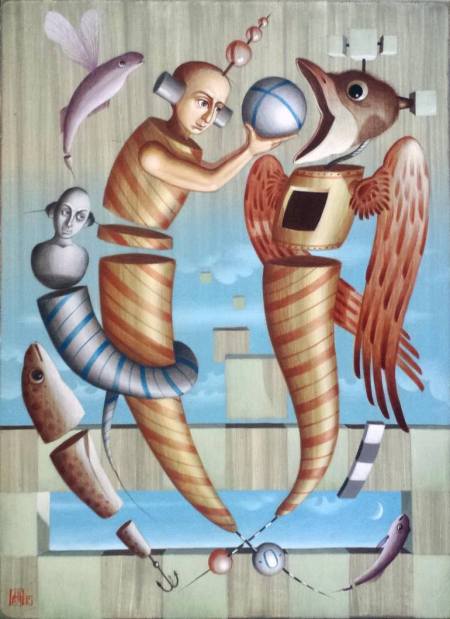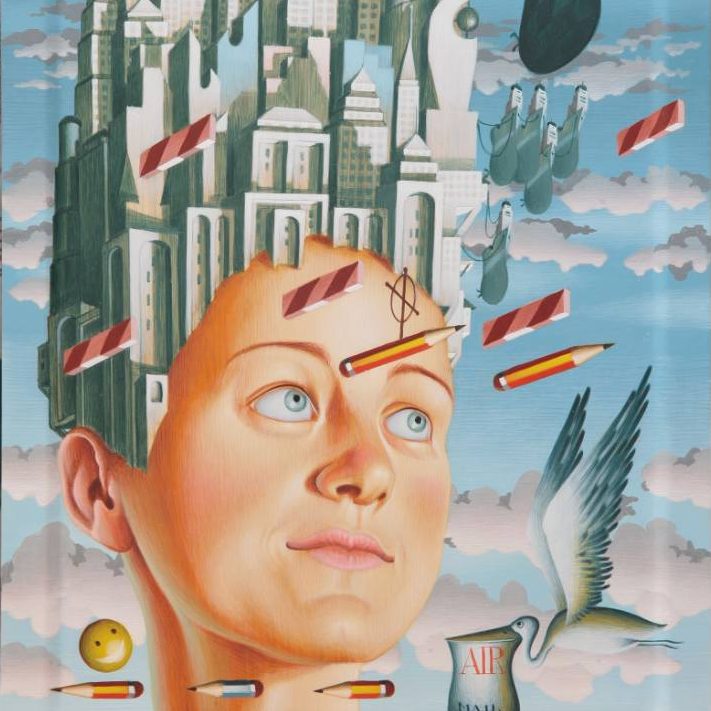Who is Dragan Jovanović? They say – “A spider that draws invisible lines in his paintings, a short pencil which can be, at the same time, an embryo of the whole universe or a rhapsodic dragon that was separated from the earth and sneaked into an area where our persistent glances can’t reach and where our understanding realises the uselessness of its efforts. All these three and above all an eternal boy and a restless nomad, who, like Noah, built his boat and set out into endless wandering around cosmic spaces, so that he can save his boyhood in constant play, wonder and discovery.” There are as many Dragan Jovanovićs in Serbia as there are John Smiths in England! The one that I am talking about has installed a mysterious watch tower in the shelter of his anonymity, from where he carefully and persistently watches the world around him. The world in himself, too. The world in books, textbooks, monographs, as well.
A resident of the city of Čačak, this Dragan Jovanović (born 1964) attended university in Belgrade and painted icons for two decades. The icon presents something lying beyond, God’s perfect wisdom, a comforting truth about the end of all pains – in this traditional art form the artist is an expert. But for the past three years, while not totally deviating from the medium of his expertise, he has been taking his art to newer directions.
Dragan’s canvas is a lyrically spread space, filled with strange happenings: removals and migrations, finished and unfinished chess matches, strange travelers who wander through the celestial expanse, pencils, toys and insects. In this special scenography, windows open to heaven beyond heaven. Motifs of endless journeys, departures and meetings create a joyful, hymn-like vision.
Where do gigantic insects, dolphins and turtles travel? To which distant country do ships and cars fly? Where are colourful eggs and chess-pieces carried? Who draws the moves in chess matches that take place at levels we can hardly understand, and who are the inhabitants of the megapolis built on the hulls of ships or the heads of humans, who, like a castle in the air from a fairytale, lies “hanging in the air”? The answers to these and many other enigmas that are placed before us by the Serbian painter are hidden in his painting itself, in its being and nature, in the coats of colours that lie on the wooden board, graded and measured in a way that, in the totality of his vision, make the impression of brightness, airiness and lightness.
Dragan explains his art: “My painting is based on Byzantine and Renaissance heritage but I also draw inspiration from ancient Egypt, Greece and Rome. I have been influenced by a large number of artists. I would particularly single Hieronymus Bosch and Pieter Bruegel, of course. Then certain European artists who painted the fantastic. From Serbian art, the greatest influence has been Mediala [an artistic group founded in 1953 in Belgrade], Dado Djuric, Leonid Šejka and a whole range of extraordinary Serbian and ex-Yugoslav painters. A special effect comes from the medieval Serbian painting.”
He comments on the significance of chess and dwarfish figures in his work: “The chess board is a battlefield of good and evil, joy and sorrow, a place where heaven and hell face each other. The eternal struggle of man with himself and his own desire to overcome the darkened side of the personality. Dwarves in my paintings are all of us in different life circumstances. Their beards are symbols of the wisdom that we want to reach. Wisdom that we so need and which, today, is increasingly difficult to acquire.”
Dragan wants the audience to search his art closely and think about the themes he is raising. If, after examining the depth of the image, its space and content and purpose, the viewer smiles or asks questions, then his effort will not have been in vain.
The artist further adds: “Painting is a big mission. The good artist must be serious and responsible to those they love. Entirely devoted to the task. Persistent and bold, inspired and witty, knowledgeable and lucid. They must express themselves in the best possible way and give joy to people. They must be authentic and rise above the ocean of mediocrity in the world. They must be committed to suppressing evil and darkness and depressing feelings of nothingness and proclaim a vision of existence that is bright and happy, harmonious and beautiful. That’s my attitude!”
Take a look at some of Dragan’s highly imaginative and playful pieces below. More on his blog (draganjovanovic1609.blogspot.com), Saatchi Art (www.saatchiart.com/draganjovanovic), Facebook (www.facebook.com/draganjovanovic1609) and Twitter (twitter.com/draganj66882220) pages.












![]()

Utterly blissful!
LikeLiked by 1 person
Wow, his work is incredibly beautiful and very unusual. Thank you for bringing sharing his work with us!
LikeLiked by 2 people
You’re welcome! 🙂
LikeLike
The mix of childish innocence with a deeper sense of sadness about the world makes his art eerie..
LikeLiked by 1 person
That’s an interesting way of looking at it. Thanks for stopping by! 🙂
LikeLiked by 1 person
Amazing work of Art ! Thanks for visiting my posts. Nice meeting you.
LikeLiked by 1 person
Thanks for visiting and commenting!
LikeLiked by 1 person
Such unique images!
LikeLiked by 1 person
Very!! 😀
LikeLike
Many thanx for introducing this artist to us. I really love this style of artwork.
LikeLiked by 1 person
Thanks! I thought of contacting him the moment I discovered his work. Amazing stuff. 🙂
LikeLike
Inspiring post! I love the idea of rising above the ocean of mediocrity in the world. I definitely agree that being as authentic as possible is key in attracting a curious, and caring audience.
LikeLiked by 1 person
Thanks for commenting! Dragan is a great soul!
LikeLike